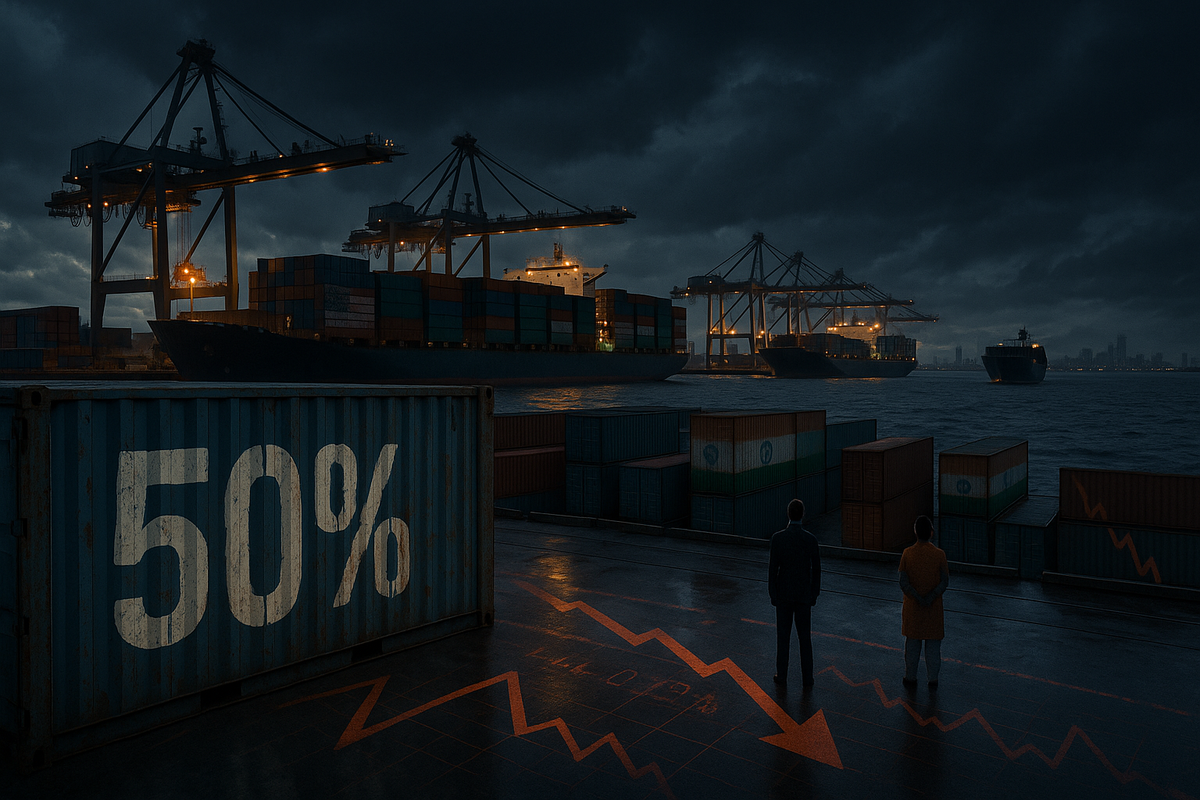
August 27, 2025 – Global trade tensions have re-escalated dramatically today as the Trump administration officially doubled tariffs on a broad range of Indian imports, bringing the total duty to a staggering 50%. This aggressive move, impacting billions of dollars worth of goods, immediately sends shockwaves through the financial markets and signals a significant deterioration in the economic relationship between two of the world's largest democracies. The tariffs, described by some analysts as an "economic earthquake," are primarily a punitive measure against India's continued purchase of discounted Russian oil amidst the ongoing conflict in Ukraine, alongside persistent frustrations over market access for U.S. goods.
The immediate implications are severe for India's export-oriented economy, particularly for its labor-intensive sectors. Indian equities have already shown signs of stress, with the BSE Sensex and Nifty 50 experiencing declines in the wake of the initial tariff threats. U.S. consumers, on the other hand, are likely to face higher prices for a range of products, from apparel to seafood, as supply chains scramble to adjust to the new, costly landscape.
What Happened and Why It Matters
Effective just after midnight on August 27, 2025, U.S. Customs and Border Protection began implementing the additional 25% tariff on most Indian imports, bringing the cumulative duty to 50%. This rate combines an earlier 25% "reciprocal" tariff imposed in April 2025 and a new 25% penalty specifically tied to New Delhi's sourcing of Russian crude oil. The move makes Indian goods some of the most heavily tariffed in the U.S. market, often exceeding rates applied to China, Vietnam, and Bangladesh.
The timeline leading to this escalation has been a tense one. Earlier in the year, bilateral trade negotiations for a comprehensive trade agreement, aimed at doubling trade to $500 billion by 2030, began with initial optimism. However, in April 2025, the Trump administration imposed an initial 25% "reciprocal" tariff on various Indian goods. On August 6, President Donald Trump announced his intention to double these tariffs, explicitly citing India's "directly or indirectly importing Russian Federation oil." This announcement initiated a 21-day window for negotiations, which proved fruitless. A scheduled round of bilateral trade talks in New Delhi was postponed by the U.S. on August 25, followed by the CBP guidance on August 26, culminating in today's implementation.
Key players in this unfolding trade saga include the Trump Administration, with President Donald Trump himself spearheading the policy, supported by figures like Treasury Secretary Scott Bessent, who criticized India for "profiteering" from Russian oil. Vice President J.D. Vance also weighed in, stating the tariffs would make it harder "for the Russians to get rich from their oil economy." On the Indian side, Prime Minister Narendra Modi has maintained a stance of strategic autonomy, asserting India's right to secure its energy needs while vowing to "stand like a wall" to protect Indian farmers, fishermen, and small businesses from U.S. demands for market access. The Indian Ministry of External Affairs has denounced the tariffs as "unfair, unjustified, and unreasonable."
Initial market reactions in India have been one of significant uncertainty. While Indian bourses were closed today for a Hindu festival, equity benchmarks had already logged declines following earlier tariff threats. Gold futures, seen as a safe-haven asset, jumped to a record high earlier in August. Indian exporters are expressing deep concern, with many considering scaling down operations or aggressively seeking alternative markets. Economists like Santanu Sengupta of Goldman Sachs warn that sustained 50% levies could push India's GDP growth below 6% from a forecast of around 6.5%.
India's Export Powerhouses Face the Brunt: Winners and Losers Emerge
The doubled tariffs are set to re-sculpt the competitive landscape for Indian industries, creating clear losers among export-dependent sectors and offering relative relief, or even a comparative advantage, to those either exempted or catering primarily to the domestic market. The Indian government estimates approximately $48.2 billion worth of its exports will be impacted.
Among the most significant losers are India's labor-intensive export sectors. The Gems and Jewellery sector, with the U.S. being its largest market, accounting for nearly 30-40% of global sales, faces a devastating blow. Tariffs, potentially rising from 2.1% to over 50% on diamonds, will render Indian products uncompetitive. Publicly listed giants like Titan Company Ltd. (NSE: TITAN), Kalyan Jewellers India Ltd. (NSE: KALYANKJIL), Rajesh Exports Ltd. (BSE: 531500), and Vaibhav Global Ltd. (NSE: VGL) could see their U.S. expansion plans halted and profit margins squeezed.
The Textiles and Apparel sector, including ready-made garments, home textiles, and carpets, is another casualty, heavily reliant on U.S. demand. Tariffs on ready-made garments could surge to 61% from around 13.9%. Major textile exporters such as Welspun India Ltd. (NSE: WELSPUNIND), Raymond Ltd. (NSE: RAYMOND), Trident Ltd. (NSE: TRIDENT), K.P.R. Mill Ltd. (NSE: KPRMILL), and Alok Industries Ltd. (NSE: ALOKINDS) are expected to face substantial pressure on sales volumes and profitability. The Shrimp and Seafood industry, with the U.S. as its top market, could see total tariffs reaching 60%, making Indian shrimp uncompetitive against rivals like Ecuador.
The Automotive Components sector is also in the crosshairs. Exporters like Bharat Forge Ltd. (NSE: BHARATFORG), with 40-45% U.S. revenue share, and Sona Comstar Ltd. (NSE: SONACOMS), with 30-35% U.S. exposure, are likely to feel a significant pinch. Furthermore, Indian Oil Refiners, though not directly tariffed on petroleum products, could face a "double whammy" if the U.S. pressure forces them to diversify away from discounted Russian oil, impacting their profitability. Companies such as Reliance Industries Ltd. (NSE: RELIANCE), Bharat Petroleum Corporation Ltd. (NSE: BPCL), Hindustan Petroleum Corporation Ltd. (NSE: HINDUNILVR), and Indian Oil Corporation Ltd. (NSE: IOC) might see their crude sourcing strategies shift.
While the overall outlook is bleak for many, there are relative beneficiaries. The Pharmaceuticals sector, particularly generic drugs and Active Pharmaceutical Ingredients (APIs), has largely been exempted from the 50% tariffs. This provides a comparative "win" for companies like Dr. Reddy's Laboratories Ltd. (NSE: DRREDDY), Sun Pharmaceutical Industries Ltd. (NSE: SUNPHARMA), Cipla Ltd. (NSE: CIPLA), Lupin Ltd. (NSE: LUPIN), and Aurobindo Pharma Ltd. (NSE: AUROPHARMA), whose competitiveness in the U.S. market remains intact due to the U.S.'s reliance on India for affordable healthcare. Similarly, Electronics, especially smartphone manufacturing for U.S. brands by partners like Tata Electronics, Foxconn, Wistron, and Pegatron in India, also enjoys exemptions, potentially solidifying India's role in these supply chains. Companies with diversified export markets or a strong domestic focus are also poised for greater resilience.
A Broader Ripple: Industry Impact and Global Repercussions
This aggressive tariff hike by the U.S. fits squarely into a global trend of resurgent protectionism and the weaponization of trade for geopolitical ends. The explicit link to India's Russian oil purchases underscores a shift where economic policy is increasingly intertwined with foreign policy, pressuring nations to align with specific geopolitical stances. This move is likely to accelerate the global push for supply chain diversification, as companies seek to reduce over-reliance on single countries and build more resilient, albeit potentially costlier, sourcing networks. It also contributes to a broader narrative of de-globalization, where national interests often supersede free trade principles.
For India, the ripple effects are profound. Beyond the immediate economic blow to specific sectors, the tariffs risk damaging its global standing as a reliable manufacturing hub and a rising economic power. The government's response, emphasizing "Swadeshi" (self-reliance) and boosting domestic consumption, aims to mitigate some of the export losses. However, the tariffs have also strained the once-warm diplomatic and strategic ties with the U.S., potentially complicating defense partnerships and undermining joint regional initiatives like the Quad. This could prompt India to further diversify its strategic alliances, possibly strengthening economic and political ties with countries like Russia and China.
On the U.S. side, the tariffs are expected to lead to higher prices for American consumers on a range of imported goods and increased costs for U.S. businesses reliant on Indian inputs. While the administration aims to address trade imbalances and exert geopolitical pressure, the move risks inadvertently slowing the broader strategy of diversifying supply chains away from China if other viable partners are alienated. Continued diplomatic engagement is likely, as both sides acknowledge the strategic importance of their relationship despite the trade friction.
Historically, this trade conflict draws parallels to previous U.S. trade skirmishes. The US-China Trade War also saw the imposition of significant tariffs driven by economic imbalances and strategic competition, although the U.S. tariffs on Chinese goods peaked much higher (145%). The key difference with India, however, lies in the direct geopolitical trigger concerning Russian oil. Similar to the US-Canada/Mexico trade conflicts during the renegotiation of NAFTA, the Trump administration is again using tariffs as a blunt instrument to exert pressure. Even further back, the Super 301 actions against India in 1989, which threatened punitive measures for "unfair trade practices," also targeted India's protectionist policies. However, the current situation is complicated by the direct linkage to the Russia-Ukraine conflict, adding a layer of international political tension to the economic dispute.
What Comes Next: Navigating the Turbulent Waters
The path forward for both India and the U.S., as well as the global trading system, is fraught with uncertainty. In the short term, India's export-oriented sectors will experience severe contraction, leading to job losses and a tangible hit to its GDP growth. Manufacturers in key textile hubs like Tirupur have already reported production halts due to insurmountable cost competitiveness issues. U.S. importers will continue to re-align their supply chains, seeking alternatives in countries such as Vietnam, Bangladesh, and Ecuador, leading to higher consumer prices for affected goods in the U.S.
In the long term, India is expected to maintain its non-retaliatory but strategically self-reliant approach. The Indian government has pledged support for affected sectors through various measures, including financial aid for exporters, tax reductions, and efforts to simplify the Goods and Services Tax (GST). Critically, India will aggressively pursue new export markets beyond the U.S., with plans to target over 40 countries, including the UK, Japan, and South Korea, and accelerate trade deals with blocs like the European Union. This strategic pivot could ultimately lead to a more diversified and resilient Indian export base, albeit after a period of considerable pain. Geopolitically, the tariffs could push India towards strengthening ties with traditional allies like Russia and stabilizing relations with China, particularly concerning trade settlement in national currencies to reduce U.S. dollar reliance.
For the U.S., the challenge will be to balance its geopolitical objectives with the economic costs to its consumers and businesses. While the tariffs aim to incentivize domestic production and reduce reliance on specific nations, they risk inadvertently slowing the broader strategy of diversifying supply chains away from China if other viable partners are alienated. Continued diplomatic engagement is likely, as both sides acknowledge the strategic importance of their relationship despite the trade friction.
Potential scenarios range from a sustained economic strain and divergence, where India steadily reduces its economic reliance on the U.S. while U.S. supply chains re-align at higher costs, to a partial de-escalation through negotiation. The latter might involve India making some concessions, such as on market access for U.S. agricultural goods or adjusting its Russian oil purchases, in exchange for tariff relief. A full-scale trade war is a lower-probability, high-impact scenario that would severely damage bilateral trade and global economic growth. Ultimately, India's resilient pivot to accelerate domestic manufacturing and diversify its global partnerships represents a long-term opportunity to emerge as a stronger, more independent player on the world stage.
Conclusion: A New Era of Trade, Turbulence, and Transformation
The doubling of U.S. tariffs on Indian imports marks a critical juncture in the bilateral relationship, underscoring a global landscape where trade policy is increasingly weaponized for geopolitical ends. The immediate economic impact on India's labor-intensive export sectors is expected to be profound, threatening jobs and dampening GDP growth. For U.S. consumers, higher prices for everyday goods will be an unwelcome consequence.
The market moving forward will be characterized by significant volatility in Indian equities, particularly for companies exposed to the U.S. export market. India's strategic response, focusing on self-reliance and aggressive diversification of export markets, will be crucial in mitigating the long-term damage. This crisis acts as a potent catalyst for India to accelerate domestic manufacturing, foster innovation, and forge new trade agreements that lessen its vulnerability to unilateral trade actions.
The lasting impact could be a fundamental reorientation of India's global trade and diplomatic relationships, potentially leading to closer ties with non-Western blocs and a more assertive stance on its strategic autonomy. For the U.S., while the tariffs aim to address specific grievances, they risk unintended consequences, including alienating a key strategic partner and disrupting its own supply chain diversification efforts.
Investors should closely watch:
- The performance of affected Indian sectors like textiles, gems and jewelry, and seafood, monitoring order books, production levels, and financial results.
- Indian government interventions, including new credit schemes, tax relief, and progress on new free trade agreements.
- Global supply chain adjustments, observing how swiftly U.S. buyers shift sourcing to other countries and the implications for global trade flows.
- Geopolitical developments, particularly the evolution of U.S.-India relations, India's engagement with Russia and China, and any further trade rhetoric or actions.
- Inflation in the U.S. for goods impacted by the tariffs, as this will indicate the extent of cost pass-through to consumers.
This period of trade turbulence, while challenging, will undoubtedly be transformative, reshaping economic partnerships and accelerating strategic realignments on the global stage.





